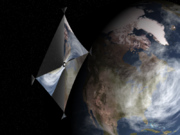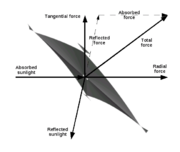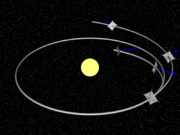Difference between revisions of "Solar Sailing 101"
(Added more material and images) |
(→What is a Solar Sail?: modified wording) |
||
| Line 7: | Line 7: | ||
* Why does sunlight push a solar and not the solar wind? | * Why does sunlight push a solar and not the solar wind? | ||
| − | ==What | + | ==What are Solar Sails?== |
[[Image:WSFsailcraft_Earth.png|thumb|Square sail with steering vanes near Earth]] | [[Image:WSFsailcraft_Earth.png|thumb|Square sail with steering vanes near Earth]] | ||
| − | A solar sail is a large, lightweight mirror | + | A solar sail is a large, lightweight mirror used to propel a spacecraft using the pressure exerted by sunlight. In essence, it works like a sailboat. Whereas a sailboat is propelled by deflecting the wind, a solar sail is propelled by deflecting sunlight. Solar pressure is very weak - about 9 millionths of a Newton (micro-Newtons) or 2 millionths of a pound (micro-pounds) of force on a square meter at Earth's distance from the sun. This is far too little pressure to have any effect on Earth, because other forces are much larger, like air drag and gravity driving us into the ground. In space there is no air drag and objects fall freely under the influence of gravity without the ground to constrain them. Sunlight can have a significant effect on objects, depending on how lightweight they are. Large and lightweight objects are affected more. Dust given off by comet is pushed into brilliant tails millions of kilometers long. Spacecraft accumulate small errors due to sunlight in their orbits and their spin over long time periods. Even asteroids gradually change their spin over millions of years. A solar sails can accelerate quickly enough to travel between planets or change the behavior of its orbit around a planet or the sun - without consuming any propellant. |
==How Does Light Push a Solar Sail?== | ==How Does Light Push a Solar Sail?== | ||
Revision as of 17:28, 8 June 2009
Contents |
Introduction
Hopefully by reading this document, you will be able to answer these questions when the topic of solar sails comes up:
- What is a solar sail?
- How does a solar sail work?
- Why does sunlight push a solar and not the solar wind?
What are Solar Sails?
A solar sail is a large, lightweight mirror used to propel a spacecraft using the pressure exerted by sunlight. In essence, it works like a sailboat. Whereas a sailboat is propelled by deflecting the wind, a solar sail is propelled by deflecting sunlight. Solar pressure is very weak - about 9 millionths of a Newton (micro-Newtons) or 2 millionths of a pound (micro-pounds) of force on a square meter at Earth's distance from the sun. This is far too little pressure to have any effect on Earth, because other forces are much larger, like air drag and gravity driving us into the ground. In space there is no air drag and objects fall freely under the influence of gravity without the ground to constrain them. Sunlight can have a significant effect on objects, depending on how lightweight they are. Large and lightweight objects are affected more. Dust given off by comet is pushed into brilliant tails millions of kilometers long. Spacecraft accumulate small errors due to sunlight in their orbits and their spin over long time periods. Even asteroids gradually change their spin over millions of years. A solar sails can accelerate quickly enough to travel between planets or change the behavior of its orbit around a planet or the sun - without consuming any propellant.
How Does Light Push a Solar Sail?
Electromagnetism
Before anyone ever took a beam of light and measured how much it could push, there were predictions that light could exert a very gentle push on objects it hits. James Clerk Maxwell developed the laws describing electromagnetism and concluded that light is an electromagnetic wave. Maxwell predicted that when light hits an object and is absorbed or reflected, the light wave pushes on electric charges in the surface of the object, which in turn push on the rest of the object. If the light is reflected, the object gets pushed twice as hard, just as if you would be pushed twice as hard by a rubber ball hitting you as a ball of clay. In 1901-1903, the Americans Nichols and Hull and Russian Lebedev were able to measure light pressure as predicted by Maxwell. Find a physics text that discussed electromagnetism, like Physics, by Halliday, Resnick, and Krane, to see how the force is derived from Maxwell's equations.
Einstein
When Einstein developed his theories of relativity, and gave us the equation , it allowed us to calculate light pressure a lot easier.
compares energy, which can be easily measured in light, to mass and movement, which can easily be used to find forces.
- E is an amount of energy
- m is an amount of mass
- c is the speed of light, about 300 million meters per second
If you fiddle around with , you find that the force light exerts is the power of the sunlight divided by the speed of light. Like I stated above, you get twice as much force from an object that reflects all the light as you do from an object that absorbs all the light. In order to get this simple formula, force equals power divided by speed of light, the steps taken by Maxwell and others had to be taken first.
Very, Very, Gentle Force
Sunlight exerts a very gentle force. The power of sunlight in space at Earth's distance from the sun is between 1.3-1.4 kilowatts per square meter. When you divide 1.4 kilowatts by the speed of light, about 300 million meters per second, the result is very small. A square mirror 1 kilometer on a side would only feel about 9 Newtons or 2 pounds of force. Fortunately, space is very empty and clean compared to Earth, so there is plenty of room for a 1 kilometer wide sail to maneuver, and there is no noticeable friction to interfere with your 9 Newtons of thrust. A sailboat on Earth wouldn't be going anywhere with that little force because of drag from the water and air. Some rockets can push millions of times harder, but the sail keeps pulling so long as light shines on it. Months or years after the rocket runs out of fuel, the sail is still pulling.
Why Don't Solar Sails Use the Solar Wind?
Many people assume that because here on Earth they feel wind but not sunlight, that solar sails must be pushed by the solar wind. However, there is a very big difference between space and Earth. Earth is wrapped in a thick layer of gas that is felt as wind whenever it moves. In space, there is no air to move around and cause strong winds like we feel on Earth. The solar wind is an extremely tenuous flow of particles ejected by the sun which exerts very little force on anything it hits. In fact, the solar wind can have 1000-10,000 times less force on a solar sail than sunlight. People worry about the solar wind for other reasons. Solar storms can hurt people and electronics in space. Increases in the solar wind can cause the upper atmosphere to swell and increase drag on low Earth orbit spacecraft. The solar wind can be used to push magnetic sail or plasma sail spacecraft.
Solar Sailing
When a sail is pointed directly at the sun, it experiences a force as described above - the sun pushes the sail directly away from it at a force twice that of an object that absorbs the sunlight. The reflected light generates a reaction force as it leaves the sail, much like the exhaust of a rocket. When the sail is tilted at an angle to the sunlight, two things happen: less sunlight is intercepted by the sail and the forces from absorbed and reflected sunlight are no longer in the same direction. As the sail is tilted, the total force will drop until it becomes zero when the sail is edge-on to the sun. The absorbed sunlight and a portion of the reflected sunlight will always push directly away from the sun (called the radial force), but when the sail is tilted, there will be a portion of the reflected light that pushes perpendicular or tangent to the sunlight. This force component, called the tangential force, can be used to maneuver in space.
"Tacking"
Spacecraft normally coast in orbits around the sun or a planet. Rockets are used to apply a quick force to change the orbit to transfer to another area. Once reaching the new location, a second rocket burn places the spacecraft into the destination orbit. Solar sails, using the tangential force, can also change their orbits like a rocket. The difference is that the solar sail generates very low thrust that can run over the entire orbit transfer, rather than just a short powerful burst at either end. Instead of coasting to the destination, the sail gradually alters the orbit over time. Despite having a force component pushing away from the sun, the tangential force allows a sail to both travel towards and away from the sun. Like a rocket, if the tangential force is in the same direction as the spacecraft's orbit, the orbit will expand and the sail will travel out from the sun. If the sail is tilted the other direction so that the tangential force goes against the orbit, the orbit will contract and the sail will spiral in closer to the sun. This is able to overcome any complications caused by the portion of the force pushing out.
- Also see: Tacking Solar Sails



